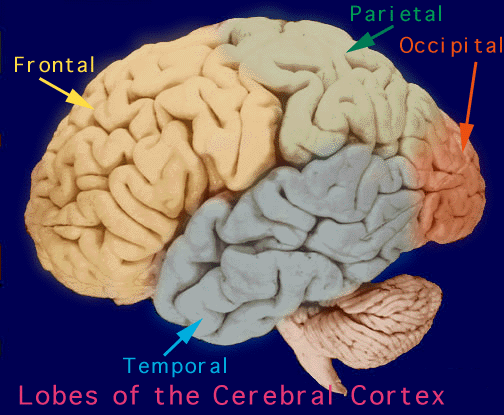Remote Ready Biology Learning Activities has 50 remote-ready activities, which work for either your classroom or remote teaching.
Serendip is an independent site partnering with faculty at multiple colleges and universities around the world. Happy exploring!
This web exhibit was first built in 2000 by Patricia Anne Kinser, Haverford College, under the direction of Paul Grobstein, Bryn Mawr College. The updated version of Comparative Neuroanatomy and Intelligence is now online at http://serendipstudio.org/exchange/brains. This old version has been archived in place, and will continue to be available for teachers and students who are using it. |
|
Brain Structures and their Functions
The nervous system is your body's decision and communication center. The brain is made of three main parts: the forebrain, midbrain, and hindbrain. The forebrain consists of the cerebrum, thalamus, and hypothalamus (part of the limbic system). The midbrain consists of the tectum and tegmentum. The hindbrain is made of the cerebellum, pons and medulla. Often the midbrain, pons, and medulla are referred to together as the brainstem.
The Cerebrum: The cerebrum or cortex is the largest part of the human brain, associated with higher brain function such as thought and action. The cerebral cortex is divided into four sections, called "lobes": the frontal lobe, parietal lobe, occipital lobe, and temporal lobe. Here is a visual representation of the cortex:
 What do each of these lobes do?
Note that the cerebral cortex is highly wrinkled. Essentially this makes the brain more efficient, because it can increase the surface area of the brain and the amount of neurons within it. We will discuss the relevance of the degree of cortical folding (or gyrencephalization) later. (Go here for more information about cortical folding) A deep furrow divides the cerebrum into two halves, known as the left and right hemispheres. The two hemispheres look mostly symmetrical yet it has been shown that each side functions slightly different than the other. Sometimes the right hemisphere is associated with creativity and the left hemispheres is associated with logic abilities. The corpus callosum is a bundle of axons which connects these two hemispheres. Nerve cells make up the gray surface of the cerebrum which is a little thicker than your thumb. White nerve fibers underneath carry signals between the nerve cells and other parts of the brain and body. The neocortex occupies the bulk of the cerebrum. This is a six-layered structure of the cerebral cortex which is only found in mammals. It is thought that the neocortex is a recently evolved structure, and is associated with "higher" information processing by more fully evolved animals (such as humans, primates, dolphins, etc). For more information about the neocortex, click here.
The Cerebellum: The cerebellum, or "little brain", is similar to the cerebrum in that it has two hemispheres and has a highly folded surface or cortex. This structure is associated with regulation and coordination of movement, posture, and balance. The cerebellum is assumed to be much older than the cerebrum, evolutionarily. What do I mean by this? In other words, animals which scientists assume to have evolved prior to humans, for example reptiles, do have developed cerebellums. However, reptiles do not have neocortex. Go here for more discussion of the neocortex or go to the following web site for a more detailed look at evolution of brain structures and intelligence: "Ask the Experts": Evolution and Intelligence Limbic System: The limbic system, often referred to as the "emotional brain", is found buried within the cerebrum. Like the cerebellum, evolutionarily the structure is rather old. This system contains the thalamus, hypothalamus, amygdala, and hippocampus. Here is a visual representation of this system, from a midsagittal view of the human brain:
Click on the words to learn what these structures do:
Brain Stem: Underneath the limbic system is the brain stem. This structure is responsible for basic vital life functions such as breathing, heartbeat, and blood pressure. Scientists say that this is the "simplest" part of human brains because animals' entire brains, such as reptiles (who appear early on the evolutionary scale) resemble our brain stem. Look at a good example of this here.
The brain stem is made of the midbrain, pons, and medulla. Click on the words to learn what these structures do:
| Forum | Brain and Behavior | Serendip Home | Send us your comments at Serendip © by Serendip 1994- - Last Modified: Wednesday, 02-May-2018 11:57:52 CDT |